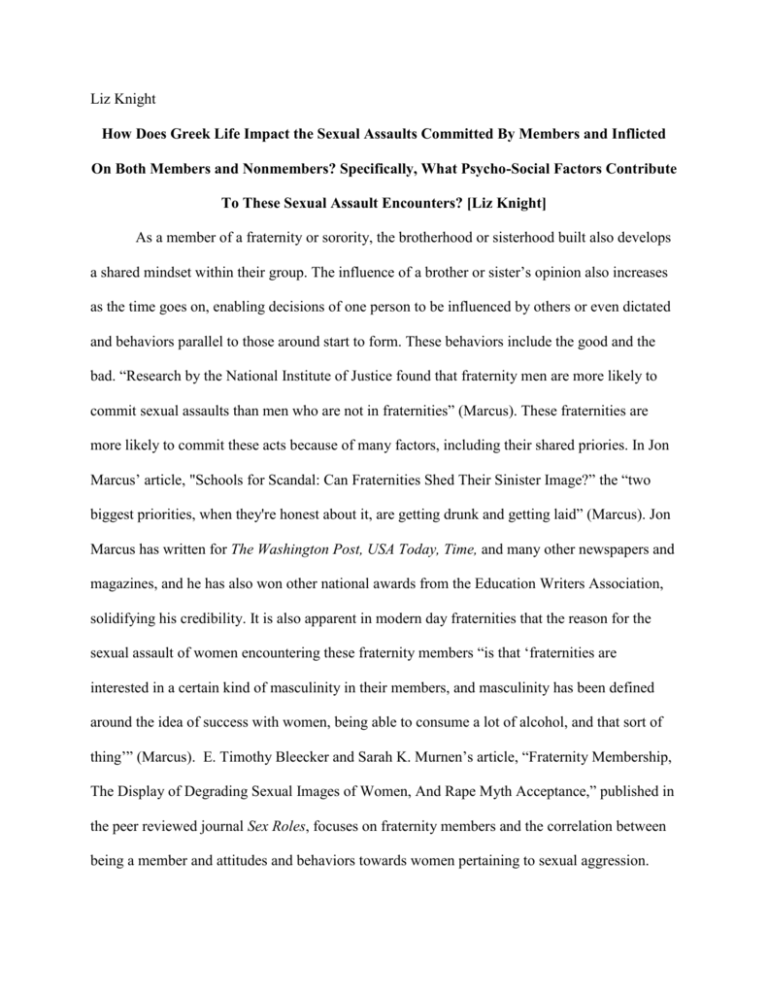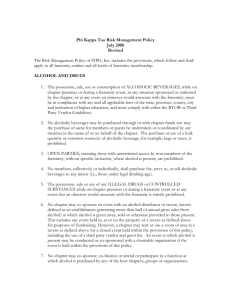
Liz Knight
How Does Greek Life Impact the Sexual Assaults Committed By Members and Inflicted
On Both Members and Nonmembers? Specifically, What Psycho-Social Factors Contribute
To These Sexual Assault Encounters? [Liz Knight]
As a member of a fraternity or sorority, the brotherhood or sisterhood built also develops
a shared mindset within their group. The influence of a brother or sister’s opinion also increases
as the time goes on, enabling decisions of one person to be influenced by others or even dictated
and behaviors parallel to those around start to form. These behaviors include the good and the
bad. “Research by the National Institute of Justice found that fraternity men are more likely to
commit sexual assaults than men who are not in fraternities” (Marcus). These fraternities are
more likely to commit these acts because of many factors, including their shared priories. In Jon
Marcus’ article, "Schools for Scandal: Can Fraternities Shed Their Sinister Image?” the “two
biggest priorities, when they're honest about it, are getting drunk and getting laid” (Marcus). Jon
Marcus has written for The Washington Post, USA Today, Time, and many other newspapers and
magazines, and he has also won other national awards from the Education Writers Association,
solidifying his credibility. It is also apparent in modern day fraternities that the reason for the
sexual assault of women encountering these fraternity members “is that ‘fraternities are
interested in a certain kind of masculinity in their members, and masculinity has been defined
around the idea of success with women, being able to consume a lot of alcohol, and that sort of
thing’” (Marcus). E. Timothy Bleecker and Sarah K. Murnen’s article, “Fraternity Membership,
The Display of Degrading Sexual Images of Women, And Rape Myth Acceptance,” published in
the peer reviewed journal Sex Roles, focuses on fraternity members and the correlation between
being a member and attitudes and behaviors towards women pertaining to sexual aggression.
According to the results collected by Bleecker and Murnen, theorist believe some men come to
college with pre-established beliefs on sexual assaults and do not want to abandon these beliefs,
pushing them towards joining fraternities based on the same principles (Kanin and O’Sullivan,
quoted in Bleecker and Murnen 487). Fraternity men search for those who embody the same
beliefs, strengthening their bonds. One of the main foundational beliefs of these members is the
belief of male superiority. It was also found that “compared to non-fraternity men, fraternity men
have been found to have more traditional attitudes toward women, a more sexually permissive
peer group, stronger belief in male dominance and greater belief in rape myths (Schaeffer,
Nelson, Lottes, Kuriloff and Burt, quoted in Bleecker and Murnen 487). Murnen offers a credible
supporting perspective to these results because she is a social psychologist who studies gender
related issues. The search for dominance for members of these fraternities leads to the
overpowering of others in order to achieve a bond with other members as a result of the
dominance displayed. Because there are many forms of dominance, such as fraternal, sexual and
social, “the brothers are concerned to dominate women socially and sexually. Part of the reason
they bond as a group is to achieve the domination that they believe is owed to all males” (Sanday
139). These bonding behaviors support the research collected that “have speculated that certain
behaviors associated with all-male groups might encourage attitudes supportive of SA [sexual
assault]” (Bleecker and Murnen 488). These behaviors support sexual assault as well as the
bonding practice of watching pornography together.
Pornography has become a growing problem in fraternities, corrupting the organic and
legal vision of sexual encounters partners should participate in. On a smaller scale, theorist have
“predicted that fraternity men would have more images of women in their rooms than would
non-fraternity men, that the fraternity men’s images would be more degrading, and that the
degree of degradation in the images would be correlated with the rape myths held by the men.
Empirical support was found for all these hypotheses” (Bleecker and Murnen 490). It is also
believed that degrading pictures of women support the male superiority belief held by fraternity
members and the subordinate role of women, contributing to women being targeted for acts of
sexual assault (Bleecker and Murnen 491). Fraternity men not only wake up to see pictures of
degrading women, but together they watch degrading acts being carried out on camera,
potentially leading to the viewer trying to make these encounter scenes real. Peggy Reeves
Sanday’s book, Fraternity Gang Rape: Sex, Brotherhood, and Privilege on Campus, published
by New York University Press, focuses on Fraternity life and the influence the practices these
fraternities continue to partake in have on the amount of united sexual assaults these fraternity
brothers commit together. Sanday provides accounts of fraternity gang rape and statistics about
acquaintance rape as well, supported by her credibility as a professor of anthropology. In
Sanday’s book, her study focused on the fact that because of the inexperience of some of the
virgin fraternity brothers, their knowledge was only based on the pornography watched and
stories shared about group sex, which made the brothers fully accept these practices (Sanday 91).
These brothers are building the foundation of future perpetrators of sexual assaults and these
young men are unaware of the effect the false information is having. Sanday also focused on a
specific sexual act that bonded brothers as well as degraded women. The “train” is a shared
experience for these brothers, bonding through the act of multiple fraternity members participate
in a sexual act with one female. The pornography watched together by these brothers depicts the
act of a train and “in the shared enjoyment of pornography lie two ingredients for a ‘train’:
shared titillation and a certain amount of distance between the viewer and the sex. There is a thin
line between getting off by proxy on the screen and getting off on a surrogate in the house,
especially when the pornography specifically urges the brothers to make the fantasy real”
(Sanday 140). The concept not grasped about pornography is that the scenes portrayed are
fantasies. These fraternity members are taking these scenes and using their superiority or
dominance over women to make their fantasy come to life.
In order to get these women in the position of being vulnerable enough to partake in these
tragic encounters, fraternity men use alcohol as a means of loosening these women up. The U.S.
Department of Justice funded research report, “The Campus Sexual Assault (CSA) Study,”
focuses on the background statistics of sexual assault on college campuses and is a research
report of a sexual assault study. The authors that conducted this research found that “not
surprisingly, previous research has documented that students who are members of Greek
organizations drink more frequently and heavily than nonmembers” (Krebs et al. 37). Because of
the correlation between Greek life and alcohol consumption, it is seen that sorority membership
increases the chances of being a sexual assault victim. This finding is most likely because
sorority women are more likely to be with fraternity members and drink, and these fraternity men
they associate with are more likely to sexually assault others (Krebs et al. 36). Because of the
impact of alcohol in most of the fraternity sexual assault cases, it is unsure whether Greek
affiliation is responsible for these sexual assaults or if it is the alcohol consumption (Krebs et al.
37).
Although many universities are aware of the increasing sexual assault cases within Greek
life, the administration fails to carry out any drastic punishments, turning a blind eye because of
the potential effect it could have on the university as a whole. On the financial side of the issue,
fraternities are supported by people in powerful positions who the universities depend on for
financial contributions. For example, both Bush presidents were apart of Delta Kappa Epsilon
(Marcus). To punish the responsible fraternity or sorority would be to punish the whole school,
seeing as a financial contribution might cease if the contributor is opposed to the punishment. In
a specific incident in Peggy Reeves Sanday’s book, Fraternity Gang Rape: Sex, Brotherhood,
and Privilege on Campus, an incident that was reported failed to be appropriately addressed
because
Naming the incident was threatening on several levels. First, there was the legal
level; if the incident was rape, the brothers could be prosecuted. Second, if the
incident was rape the university administration would have to take a strong stand
against the fraternity. Finally, calling the incident rape meant an effective end to
‘trains’ at fraternity parties. For all these reasons the outcome of the debate had
serious political consequence for male privilege on campus. As we shall see, in
the end male privilege won. The fraternity was only lightly punished. (Sanday 85)
The effect that the university has on the amount of sexual assault is undermined, seeing as
though if the university fails to punish these fraternities for their indiscretions, less people will
feel safe coming forward with their cases, lowering the overall morale of the school.
Annotated Bibliography
Bleecker, E. Timothy, and Sarah K. Murnen. "Fraternity Membership, the Display of Degrading
Sexual Images of Women, And Rape Myth Acceptance." Sex Roles 53.7/8 (2005): 487493. LGBT Life with Full Text. Web. 7 Oct. 2014.
This journal article was found using the VCU Libraries (Journal Search), using the search
terms “fraternity” and “rape.” [Liz Knight]
Krebs, Christopher P., Christine H. Lindquist, Tara D. Warner, Bonnie S. Fisher, Sandra L.
Martin. “The Campus Sexual Assault (CSA) Study.” Data.gov. NCJRS, Dec. 2007: 3637. Web. 12 Oct. 2014.
This article was found using the discipline specific database Data.org, using the search
term “fraternity sexual assault.” [Liz Knight]
Marcus, Jon. "Schools For Scandal: Can Fraternities Shed Their Sinister Image?" The Times
Higher Education Supplement. 23 June 2011:20. Web. 12 Oct. 2014.
This article was found using the LexisNexis Academic search engine, using the search
terms “fraternity” and “sexual assault.” [Liz Knight]
Sanday, Peggy Reeves. Fraternity Gang Rape: Sex, Brotherhood, and Privilege on Campus. 2nd
ed. New York: New York UP, 2007. Print.
This book was found using a VCU Libraries (Book Search), using the search terms
“fraternity” and “rape.” [Liz Knight]







